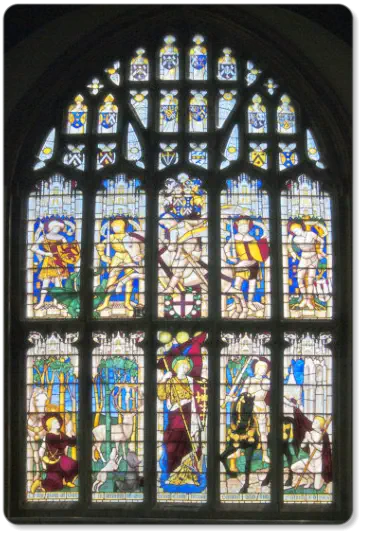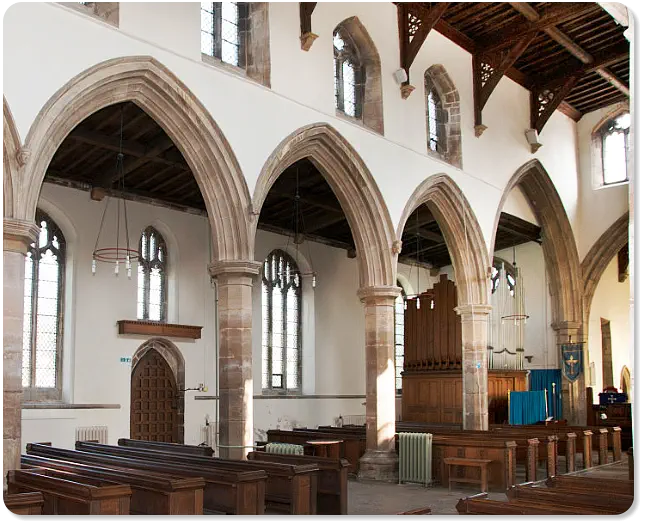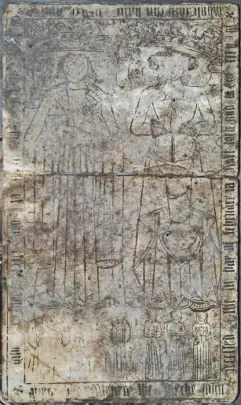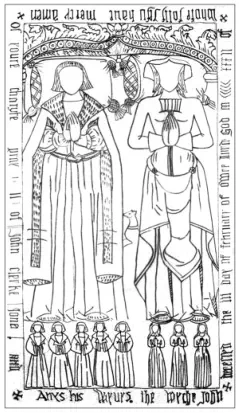The windows of the aisles are early 15th century. A very fine window is that in the south end of the
south transept. The Perpendicular tracery is very elaborate, the notch head terminations to the hood mould
denoting that it is an insertion in a 14th century arch.
The clerestory and aisle parapets are embattled, and below each is a cornice, with 15th century dog-tooth,
ball-flower, nail-head, the four-leaved flower and other ornaments.
There are five clerestory windows on each side, consisting of two lights under a depressed four centred arch.
A peculiar feature is that the clerestory and two of its windows are returned round the east end of the nave.
The windows inserted in place of the north transept are, modern.
In the floor of the nave, near the font, is a slab which had a Latin inscription, which translated reads:
“Here lie Thomas Adam, formerly of Wellhouse, senior, and Helena, his wife, merchant of the staple of Calais.
He died in the year of our Lord 1483, on the 27th day of the month of April. Thomas Adam, junior, son of the
aforesaid, also merchant of the staple of Calais, in the year of our Lord 1532, (or 1535) on whose souls may God
have mercy. Amen.” [Now too worn to read]
On the floor of the south transept, is an alabaster slab moved and damaged during Victorian alterations, its
original location was on the floor of the south aisle, northward of the transept. It shows effigies of John Clarke, his
two wives and their eight children. The text around the slabs edge reads:
“Of you’re charyte pray for the they solls of John Clarke, Jone and Anys, hys wyvys, the whiche John decessyd the
iii. day of February, in the yere of owre Lord God 1532, on whose solls Jesu have mercy, Amen.”
In the floor of the chancel were several 17th century slabs, now lost, which recorded the deaths of members of
the Cheselden family.
When ‘Wright’ visited the church during the reign of Charles II, some of the windows contained armorial glass,
exhibiting the arms of Lord Hastings (William Lord Hastings, who was murdered by command of the
Duke of Gloucester, and whose estate was confiscated when he became Richard III, was chief forester of Rutland),
the Earl of Clare and Gloucester, the Kings of East Angles, and of Beauchamp Earl of Warwick. The last-named was
a considerable landowner in Rutland.


Langham Village History Group ~ © 1996 - 2022
The Parish Church of St Peter & St Paul - The Building




The windows of the aisles are early 15th century. A very fine window is that in the south end of the
south transept. The Perpendicular tracery is very elaborate, the notch head terminations to the hood mould
denoting that it is an insertion in a 14th century arch.
The clerestory and aisle parapets are embattled, and below each is a cornice, with 15th century dog-tooth,
ball-flower, nail-head, the four-leaved flower and other ornaments.
There are five clerestory windows on each side, consisting of two lights under a depressed four centred arch.
A peculiar feature is that the clerestory and two of its windows are returned round the east end of the nave.
The windows inserted in place of the north transept are, modern.
In the floor of the nave, near the font, is a slab which had a Latin inscription, which translated reads:
“Here lie Thomas Adam, formerly of Wellhouse, senior, and Helena, his wife, merchant of the staple of Calais.
He died in the year of our Lord 1483, on the 27th day of the month of April. Thomas Adam, junior, son of the
aforesaid, also merchant of the staple of Calais, in the year of our Lord 1532, (or 1535) on whose souls may God
have mercy. Amen.” [Now too worn to read]
On the floor of the south transept, is an alabaster slab moved and damaged during Victorian alterations, its
original location was on the floor of the south aisle, northward of the transept. It shows effigies of John Clarke, his
two wives and their eight children. The text around the slabs edge reads:
“Of you’re charyte pray for the they solls of John Clarke, Jone and Anys, hys wyvys, the whiche John decessyd the
iii. day of February, in the yere of owre Lord God 1532, on whose solls Jesu have mercy, Amen.”
In the floor of the chancel were several 17th century slabs, now lost, which recorded the deaths of members of
the Cheselden family.
When ‘Wright’ visited the church during the reign of Charles II, some of the windows contained armorial glass,
exhibiting the arms of Lord Hastings (William Lord Hastings, who was murdered by command of the
Duke of Gloucester, and whose estate was confiscated when he became Richard III, was chief forester of Rutland),
the Earl of Clare and Gloucester, the Kings of East Angles, and of Beauchamp Earl of Warwick. The last-named was
a considerable landowner in Rutland.


Langham Village History Group ~ © 1996 - 2022
The Parish Church of St Peter & St Paul - The Building



















































